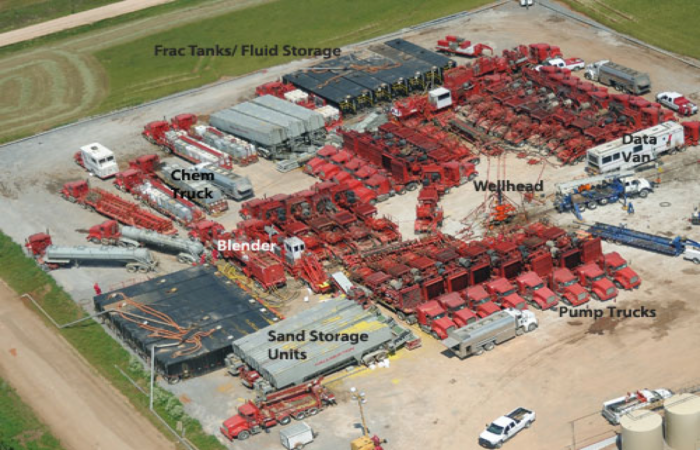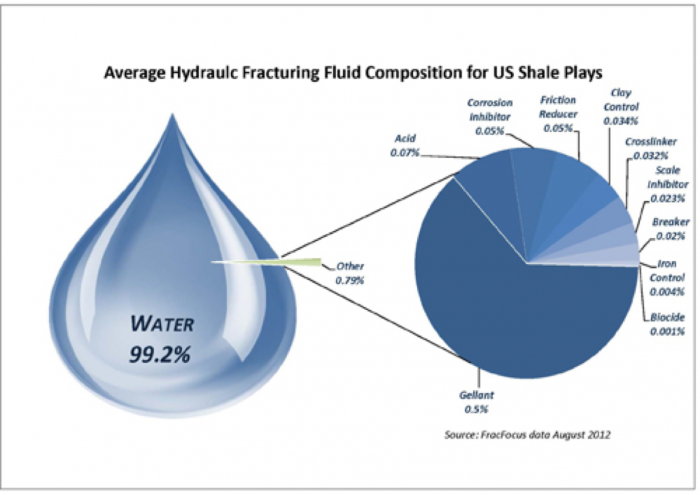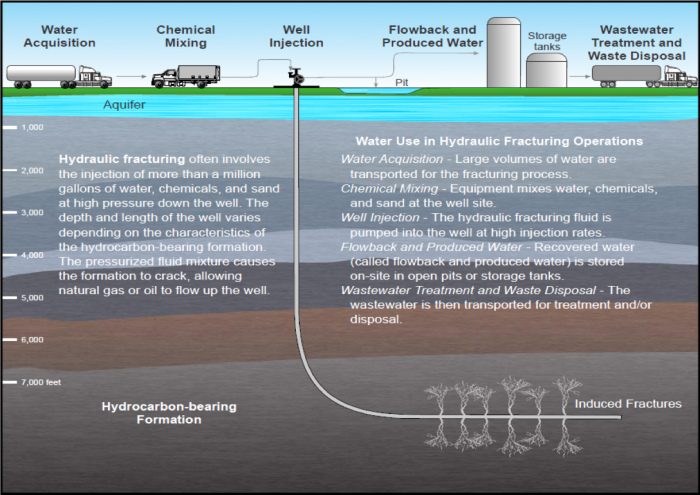Hydraulic Fracturing
Once a well has been installed, the next phase involves stimulating the surrounding shale formation for the production of hydrocarbons through the process of hydraulic fracturing. Remember the shale has a very low permeability (measured in nanodarcies, it's less permeable than concrete!), therefore fractures need to be opened up in the shale to connect pores containing oil and/or gas to provide pathways for the hydrocarbons to flow through and toward the production well. In order to hydraulically fracture the shale the following steps occur:
- A hydraulic fracturing fleet is mobilized to the site which provides the necessary equipment to hydraulically fracture the shale. The figure below shows the various types of equipment that is brought in and how it is arranged on the well pad. Water is pumped from frac tanks or impoundments (more on that later), which is then mixed with chemicals (from chem storage) and sand (from sand trailers) in the blender, which is then routed through the pump trucks to increase the pressure of the fluids high enough to fracture the shale and then inject them into the wellhead and ultimately the shale. This is all monitored from the control van to make sure the fracturing occurs according to plan.
 Figure 6.10: This picture shows a typical hydraulic fracturing site with the various types of equipment on site.Source: Frac Focus
Figure 6.10: This picture shows a typical hydraulic fracturing site with the various types of equipment on site.Source: Frac Focus- Before the shale can be fractured the initial phase includes perforating the production casing with shaped charges with a perforating gun that is sent down the well to install dime-size holes through the production casing and cement. These perforations allow communication between the well and the shale formation for hydraulic fracturing fluids to be injected into the reservoir rock surrounding the lateral at high pressure. The perforating is done in relatively short segments of the well, typically 150-250 feet long, which are known as stages. The first stage is typically at the end of the well which is known as the toe of the well. For example, a well with a lateral that is 5,000 feet long may have 25 200-foot stages in order to fracture the entire horizontal interval of the well.
- Once a stage is perforated or "perfed", that stage of the well is isolated with a special seal known as a packer or plug, and hydraulically fractured ("fraced" or "fracked") using the equipment described above. Hydraulic fracturing involves injecting a mixture of fluids as shown below at high pressure (~8,000 to >12,000 PSI) into the stage interval in the lateral, in order to fracture the rock surrounding the well adjacent to that stage. The pressurized fluid causes fractures to open, most likely pre-existing joints or bedding planes. The fractures must be "propped" open to allow hydrocarbons to flow more easily to the well. "Proppants", such as fine-grained quartz sand or ceramics, are added to the hydraulic fracture fluid as it is pumped down the well and are forced into the fractures to act as small wedges to prop the fracture open just a few sand grains wide, thus allowing hydrocarbons to flow through the now open fractures. The fracturing fluid mixture is carefully formulated in order to optimize the production from the well. The chart below shows the typical mixture of fracturing fluids, note that most of the fluid consists of water, with a small percent of a variety of compounds.
 Figure 6.11: Average Hydraulic Fracturing Fluid Composition for US Shale PlaysClick for a text description of Figure 6.11.
Figure 6.11: Average Hydraulic Fracturing Fluid Composition for US Shale PlaysClick for a text description of Figure 6.11.- Water = 99.2%
- Other = 0.79%
- Gellant = 0.5%
- Acid = 0.07%
- Corrosion Inhibitor = 0.05%
- Friction Reducer = 0.05%
- Clay Control = 0.034%
- Crosslinker = 0.032%
- Scale Inhibitor = 0.023%
- Breaker = 0.02%
- Iron Control = 0.004%
- Biocide = 0.001%
Source: FracFocus - Once a stage is fractured, it is sealed off with a plug and the next stage is perfed, fractured, and plugged. This process is repeated until all intervals of interest are fractured. Each stage may take about 4 hours to fracture. Moving equipment up and down the hole takes time and the actual time to inject fluids into the shale is 2-3 hours. The injection rate is typically measured in barrels per minute (BPM). There are 42 gallons in a barrel and the injection rate may be 80-100 BPM, so a stage may take approximately 300,000 to 400,000 gallons of fluid or about 1,500 gallons of fluids per foot of shale being fractured. In addition to that, about 1-2 pounds of proppant is used per gallon of water, therefore upwards of a ton of sand may be injected into each foot of the shale, which is hard to imagine but that's what keeps the fractures open!
- It may take a week or more to fracture a well, which means a 24/7 operation in all kinds of weather, it's definitely hard work! Once all zones have been fractured, it is time to drill out the plugs that isolate each stage. The plugs are commonly made out of a composite plastic material, which can be drilled out with a drill bit attached to a wireline unit. A wireline unit is basically a large spool of steel cable on the back of a truck that can have a variety of tools added to the end of the wireline. In this case, a bit capable of drilling out the plugs is installed to remove the plugs, which relieves the pressure on the zones of the well that have been fractured. This means any fluids in or near the wellbore will flow back out of the well at a significant rate and need to be captured in tanks. These fluids are known as flowback fluids and contain fracturing fluid additives along with naturally occurring metals, salts, and radionuclides from the shale. For Marcellus shale wells, only about 5-10% of the volume of water that is pumped down the hole returns to the surface. The shale is relatively dry so has the ability to absorb the fracturing fluids and then release them, along with the gas, during the productive life of a well, which are known as production fluids. The longer the fluids have been in the shale the higher the concentrations of salts and other contaminants. Salts, in particular, reach high levels, upwards of 350,000 mg/L, which is 10 times saltier than the ocean so it is critical to properly manage these fluids. We will cover fluids management in a few lessons.
- Once the fracturing is completed and some of the injected fluids have flowed out of the wellbore, then well will begin to produce oil, natural, gas and/or natural gas liquids and can be "turned inline", which means commercially producing hydrocarbons. For natural gas, there will be a gas/water separator near the well, which sends gas into a pipeline and produced fluids into a tank for later reuse or disposal. Oil and liquids may be captured into tanks, water and brine are separated and ultimately trucked or piped to a refinery.
 Figure 6.12: This graphic shows the water cycle for a typical shale well, including sourcing, transport, use and disposal of fluid.Click for a text description of 6.12.
Figure 6.12: This graphic shows the water cycle for a typical shale well, including sourcing, transport, use and disposal of fluid.Click for a text description of 6.12.- Steps:
- Water Aquisition → Chemical Mixing → Well Injection → Pit AND/OR Flowback and Produced Water → Storage tanks → Wastewater Treatment and Waste Disposal
- Hydraulic fracturing often involves the injection of more than a million gallons of water, chemicals, and sand at high pressure down the well. The depth and length of the well varies depending on the characteristics of the hydrocarbon-bearing formation. The pressurized fluid mixture causes the formation to crack, allowing natural gas or oil to flow up the well.
- Water Use in Hydraulic Fracturing Operations
- Water Acquisition - Large volumes of water are transported for the fracturing process
- Chemical Mixing - Equipment mixes water, chemicals, and sand at the well site.
- Well Injection - The hydraulic fracturing fluid is pumped into the well at high injection rates
- Flowback and Produced Water - Recovered water (called flowback and produced water) is stored on-site in open pits or storage tanks
- Wastewater Treatment and Waste Disposal - The wastewater is then transported for treatment and/or disposal.
Source: EPAThis video shows the hydraulic fracturing to help illustrate what we've just described.
Video: Producing Natural Gas From Shale (3:09)
Click for the video transcript.Natural gas is a clean-burning fossil fuel found deep below ground. Some natural gas is trapped within shale, a dense rock once thought beyond our reach for energy production. By combining two well-established technologies, horizontal drilling and hydraulic fracturing, we can now unlock this valuable resource. Before any drilling begins, our geologists examine rock characteristics to see if gas is likely to be present. If gas is confirmed, we determine the best location for drilling.
The natural gas will be located in shale layers. These may be as deep as 2 miles or 3.5 kilometers below the surface. That's ten times the height of the Eiffel Tower. To ensure that the subterranean area is sealed off and groundwater is protected for the life of the well, we line our wells with several layers of protective steel casing and cement. Once at the target depth, we drill horizontally about 5,000 feet or 1500 meters. This provides more access to the gas along the shale layer.
When drilling is complete, steel production casing is inserted into the horizontal section of the well. Cement is then pumped down the length of the casing and back up around it. This permanently secures the well and prevents gas and liquids from seeping out as they are brought to the surface. Next, we use an electrical perforating gun to make small holes in the steel casing and cement. Finally, to release the gas from the rock, we use hydraulic fracturing. This is a safe and proven technology that's been in use since the 1940s. A mixture of more than 99% water and sand and less than 1% additives is pumped into the well under high pressure. The mixture is pumped down the well and out through the perforations into the surrounding shale formation, creating fractures that allow gas to flow to the well. The fractures are contained within a few hundred yards or meters of the wellbore and separated from the aquifer by about one to three miles or two to four kilometers of impermeable rock.
At the surface, Chevron manages the well site to strict environmental standards. When pumping is complete, flowback water is returned from the well and captured in tanks or lined pits. Flowback water is typically either treated and reused in future hydraulic fracturing jobs or injected into permitted water disposal wells. In some locations, flowback water may be disposed of at a certified waste facility. Solids are cleaned and responsibly disposed of at a waste facility. When each well is complete, the drilling and fracturing equipment is removed and the pits are filled in. The reduced site now contains only the necessary equipment to ensure the natural gas continues to be produced safely, primarily a wellhead and related equipment. It's estimated that a typical well has a life of thirty years or more. This new generation of natural gas production can help secure a domestic energy supply and energy security for decades to come.
Credit: ChevronThe next section will discuss well production once a well is fractured.
- Steps: